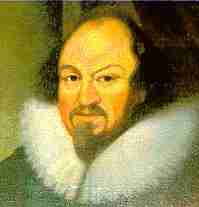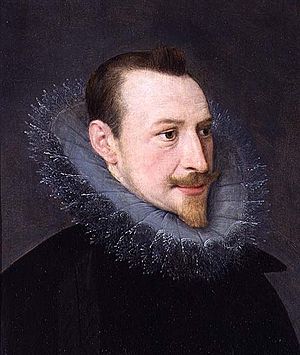Robert Travers (MP) facts for kids
Sir Robert Travers (around 1596 – 13 November 1647) was an important Irish judge, soldier, and politician in the 1600s. He had a very successful career, even though some people said he didn't always follow the rules. When big wars started, he chose to oppose King Charles I. He fought for the Irish Parliament and was killed in a major battle. He was also the nephew of the famous poet Edmund Spenser and started a family known for its military members.
Contents
Early Life and Family Connections
Robert Travers was born in County Cork, Ireland, around 1596. He was the oldest son of John Travers and Sarah Spenser. His mother, Sarah, was the sister of the well-known poet Edmund Spenser. Edmund Spenser came to Ireland in 1588 and was given land, including Kilcolman Castle. He gave some of this land to John and Sarah as a wedding gift. Robert's parents were buried in Saint Fin Barre's Cathedral in Cork, where Robert put up a memorial for them.
Starting His Career
Robert studied law at the University of Oxford. He chose to become a lawyer, which was a less common path for the oldest son of a landowning family at that time. He mainly worked in church courts and courts dealing with sea matters. People praised his legal skills, but he also gained a reputation for not always following the rules.
In 1621, he was accused of taking money unfairly while working as a church official. He was found guilty and fined, but he was never actually put in prison. Surprisingly, this didn't stop his career. He continued his legal work and was even made a knight in 1625. He likely had powerful friends, especially Richard Boyle, 1st Earl of Cork, whose cousin he later married.

Becoming a Judge
In the early 1620s, Robert became a judge in the sea-related court in Munster. Here, he again faced accusations of unfair practices and keeping valuable items from ships for himself. By 1625, even important officials were worried about his conduct. They suggested bringing back a previous judge who was known for being fair.
Later, during the Civil War, the Parliament of Ireland set up its own court and made Travers its judge. Not surprisingly, more accusations of unfairness were made against him.
In Politics
Robert became a member of the Irish House of Commons in 1634, representing Clonakilty. The town of Clonakilty was created by Lord Cork, so it's clear that Travers was chosen by him. This Parliament was called by Thomas Wentworth, 1st Earl of Strafford, who was very powerful in Ireland. Lord Cork and Strafford did not get along, as Strafford wanted to increase the King's power and reduce Cork's influence. Lord Cork worked to bring Strafford down.
Travers was re-elected to the House of Commons in 1639 and was clearly against Strafford. He signed a document in 1640 that accused Strafford of being a tyrant. Travers was very active in Parliament in 1641, pushing hard to remove Strafford from power. Like many politicians, he hoped that once Strafford was gone, the King would be able to find a peaceful agreement with the Parliaments in Ireland and England.
Civil War and Death
The start of the Irish Rebellion of 1641 showed that peace was not possible. Robert Travers, like all Protestant landowners in Ireland, became worried about his land and his life.
The Irish Parliament was suspicious of King Charles I's actions towards the Irish rebels. The rebels claimed the King supported them, and even though this was probably not true, the King did consider using the rebel army. Parliament's fears grew when the King's commander in Ireland signed a ceasefire with the rebels in 1643. Eventually, Parliament found itself fighting both the King and the rebels.
The Battle of Knocknanuss
The armies of Parliament and the Irish rebels fought a big battle at Battle of Knocknanuss, near Mallow, County Cork, on 13 November 1647. Robert Travers was a legal officer for the Parliamentary Army and also commanded a part of the army. The battle was very bloody. Even though Travers' side won, he was killed during the fighting.
His Family
Robert Travers married twice. His first wife was Catherine Nangle, but their only child likely died young. Before 1638, he married Elizabeth Boyle, who was a cousin of the Earl of Cork. With Elizabeth, he had four children:
- John (died 1712), who inherited his father's property.
- Richard (died 1700), who also inherited land from his uncle. His granddaughter later married Eaton Stannard, a well-known lawyer.
- Elizabeth, who married Colonel William Meade and had at least twelve children. Her daughter Eleanor married Jonathan Swift's uncle.
- Martha, who married twice and had children from both marriages. Her daughter Elizabeth married a famous church leader and diarist, Rowland Davies.
Some family records also show a third daughter, Alice.
Both of Sir Robert's sons started long-lasting branches of the Travers family, mainly connected to Timoleague, County Cork. Many of Robert's descendants became distinguished soldiers, including General Sir Robert Travers (1770–1834) and his son General James Travers (1820-1884).


